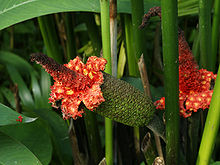Carludovica palmata
In today's world, Carludovica palmata has become a topic of great relevance and interest to a large number of people. Since its origin, Carludovica palmata has generated debate, analysis and reflection in different areas, both on a personal and professional level. Its impact on modern society is undeniable, and its influence extends to different areas, from culture and politics to technology and economics. In this article, we will explore in detail the various facets and perspectives of Carludovica palmata, with the aim of better understanding its importance and meaning in today's world.
| Panama hat plant | |
|---|---|

| |
| Scientific classification | |
| Kingdom: | Plantae |
| Clade: | Tracheophytes |
| Clade: | Angiosperms |
| Clade: | Monocots |
| Order: | Pandanales |
| Family: | Cyclanthaceae |
| Genus: | Carludovica |
| Species: | C. palmata
|
| Binomial name | |
| Carludovica palmata | |
| Synonyms | |
Carludovica palmata (Panama hat plant or toquilla palm) is a palm-like monocot plant. It is not a true palm. Its leaves are very similar compared to the leaves of some true palms, for example, to Chelyocarpus ulei. Unlike several true palms, C. palmata does not develop a woody trunk. Its female flowers (which mature first) have large stigmas, and its male flowers (which mature later) have a lot of pollen.
The Panama hat palm is cultivated from Central America to Bolivia. Its soft, flexible, and durable fibers are used to weave Panama hats and other items.
References
- ^ Brummitt, N. (2013). "Carludovica palmata". IUCN Red List of Threatened Species. 2013: e.T44392681A44401274. doi:10.2305/IUCN.UK.2013-2.RLTS.T44392681A44401274.en. Retrieved 19 December 2022.
- ^ Tropicos, Missouri Botanical Garden
- ^ Johnny Morris (8 June 2007). "Crowning glory of the Andes". The Telegraph. Retrieved 24 September 2010.


